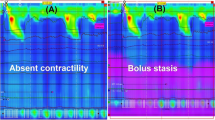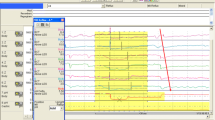Abstract
Recently, we developed a disposable acid exposure sensor whose in vitro response to acid below pH 4 is linearly determined by the duration of exposure and the degree of acidity. The aim of the present study was to compare the SR to simultaneous esophageal pH and duodenogastroesophageal reflux (DGER) monitoring (Bilitec) in patients investigated for presumed gastroesophageal reflux disease (GERD). Twenty-six patients (16 men, mean age 46 ± 2 years) with symptoms suggestive of GERD underwent 24-hr ambulatory pH monitoring and SR monitoring at 5 cm proximal to the LES. DGER monitoring was performed in 21 patients. Exposure of the esophagus to acid and to DGER were analyzed. These data were compared to SR. A significant correlation was found between the exposure of the distal esophagus to acid and SR (R = 0.85; P < 0.0001). Similarly, the area below a cutoff pH 4 was significantly correlated to SR (r = 0.81; P < 0.0001). SR was not correlated to DGER (r = 0.16; NS). At a cutoff of 50, the sensitivity and specificity of SR to predict esophageal acid exposure >5% of time were 91% and 93%, respectively conclusion, the response of the acid exposure sensor is strongly correlated with the results of simultaneous esophageal pH monitoring. The sensor seems able to reliably predict pathological esophageal acid exposure. These findings warrant larger studies of the clinical potential of the acid exposure sensor in the diagnosis and quantification of GERD.
Similar content being viewed by others
REFERENCES
Nebel OT, Fornes MF, Castell DO: Symptomatic gastro-esophageal reflux: incidence and precipitating factors. Dig Dis Sci 21:953-956, 1976
Cohen S, Parkman HP: Heartburn-a serious symptom. N Eng J Med 340:878-879, 1999
Lagergren J, Bergstrom R, Lindgren A, Nyren O: Symptomatic gastroesophageal reflux as a risk factor for esophageal adenocarcinoma N Eng J Med 340:825-831, 1999
Sampliner, RE: Adenocarcinoma of the esophagus and gastric cardia: is there progress in the face of increasing cancer incidence? Ann Intern Med 130:67-69, 1999
Carlsson R, Dent J, Watts R, Riley S, Sheikh R, Hatlebakk J, Haug K, de Groot G, van Oudvorst A, Dalvag A, Junghard O, Wiklund I: Gastro-oesophageal reflux disease in primary care: an international study of different treatment strategies with omeprazole. Eur J Gastroenterol Hepatol 10:119-124, 1998
Galmiche JP, Barthelemy P, Hamelin B: Treating the symptoms of gastro-oesophageal reflux disease: a double-blind comparison of omeprazole and cisapride. Aliment Pharmacol Ther 11:765-773, 1997
Vantrappen G, Janssens J, Ghillebert G: The irritable esophagus: a frequent cause of angina-like chest pain. Lancet 1:1233-1234, 1987
Quigley EMM: 24 hour pH monitoring for gastroesophageal re-flux disease: already standard but not yet gold. Am J Gastroenterol 87:1071-1075, 1992
Kahrilas PJ, Quigley EMM: Clinical esophageal pH recording: a technical review for practice guideline development. Gastroenterology 110:1982-1996:, 1996
Jamieson JR, Stein HJ, DeMeester TR, Bonavina L, Schwizer W, Hinder RA, Albertucci M. Ambulatory 24-h esophageal pH monitoring: normal values, optimal thresholds, specificity, sensitivity, and reproducibility. Am J Gastroenterol 87:1102-1111, 1992
Champion G, Richter JE, Vaezi MF, Singh S, Alexander R: Duodenogastroesophageal reflux: relationship to pH and importance in Barrett's esophagus. Gastroenterology 107:747-754, 1994
De Caestecker JS, Heading RC: Esophageal pH monitoring. Gastroenterol Clin North Am 19:645-649, 1990
Fink S, McCallum RW: The role of prolonged esophageal pH monitoring in the diagnosis of gastroesophageal reflu. JAMA 252:1160-1164, 1984.
Klauser AG, Heinrich C, Schindlbeck NE, et al: Is long-term esophageal pH monitoring of clinical value? Am J Gastroenterol 84:362-366, 1989
Vantrappen G, Janssens J, Huyberechts G, Van overstraeten R: A disposable probe to measure the esophageal acid burden. Gastroenterology (abstract) 108:A250, 1995
Huyberechts G, Honore R, Van Overstraeten R, Vantrappen G, Janssens J, Sifrim D, Mebis J, Geboes K: Development of a disposable probe for the evaluation of acid-induced damage of the oesophageal mucosa. Biosensors Bioelectronics 14:625-630, 1999
Vantrappen G, Tack J, Huyberechts G, Sifrim D, Geboes K, Janssens J, Van Overstraeten R: Studies on the relationship between esophageal acid exposure, mucosal lesions and heartburn using an acid exposure sensor. Scand J Gastroenterol 2002 (in press)
Savary M, Miller G: L'oesophage. Manuel et Atlas d'Endoscopie. Solothurn, Verlag Gassmann, 1977
Armstrong D, Monnier Ph, Nicolet M, Blum AL, Savary M: The “MUSE” system. In The Esophageal Mucosa. R Guili, GNJ Tytgat, TR DeMeester, JP Galmiche (eds). Amsterdam, Elsevier Science, 1994, pp 313-321
Tack J, Koek G, Bisschops R, Sifrim D, Lerut T, Janssens J: The use of dietary restrictions during ambulatory pH and bilitec monitoring. 2002 (submitted)
Murphy DW, Yuan Y, Castell DO: Does the intraesophageal pH probe accurately detect acid reflux? Simultaneous recording with two pH probes in humans. Dig Dis Sci 34:649-656, 1989
Vantrappen G, Huyberechts G, Tack J, Honore M, Janssens J, Van Overstraeten R: Further validation studies on the disposable acid burden sensor. Gastroenterology 110:A321 1997 (abstract)
Author information
Authors and Affiliations
Rights and permissions
About this article
Cite this article
Tack, J., Vantrappen, G., Huyberechts, G. et al. Validation of a New Method of Measuring Esophageal Acid Exposure: Comparison with 24-Hour pH Monitoring. Dig Dis Sci 48, 16–21 (2003). https://doi.org/10.1023/A:1021717911342
Issue Date:
DOI: https://doi.org/10.1023/A:1021717911342




